Houseplant Repotting: Pothos (Epipremnum Aureum)
Pothos are one of the quintessential easy care houseplants for beginning gardeners. They’re readily available almost everywhere and are very easy on the wallet. Because of their moderate to fast growth rate, yours will need transplanting at some point. This is all about Pothos repotting including the mix to use, steps to take and when to do it.
You’ll see me repotting my Golden Pothos and Pothos N Joy in this post and video. Other popular varieties are: Jade Pothos, Glacier, Marble Queen, Neon and Pearls & Jade. The steps taken and materials used here apply to all varieties of Pothos, no matter which one you are repotting.
Not only is a Pothos plant easy to maintain but it’s also a snap to propagate. Those long trails appear in no time and you’ll see little roots pushing out at every leaf node. I root my Pothos cuttings in water (Pothos propagation and video coming soon!) and plant them in the soil mix below once those roots are well along.
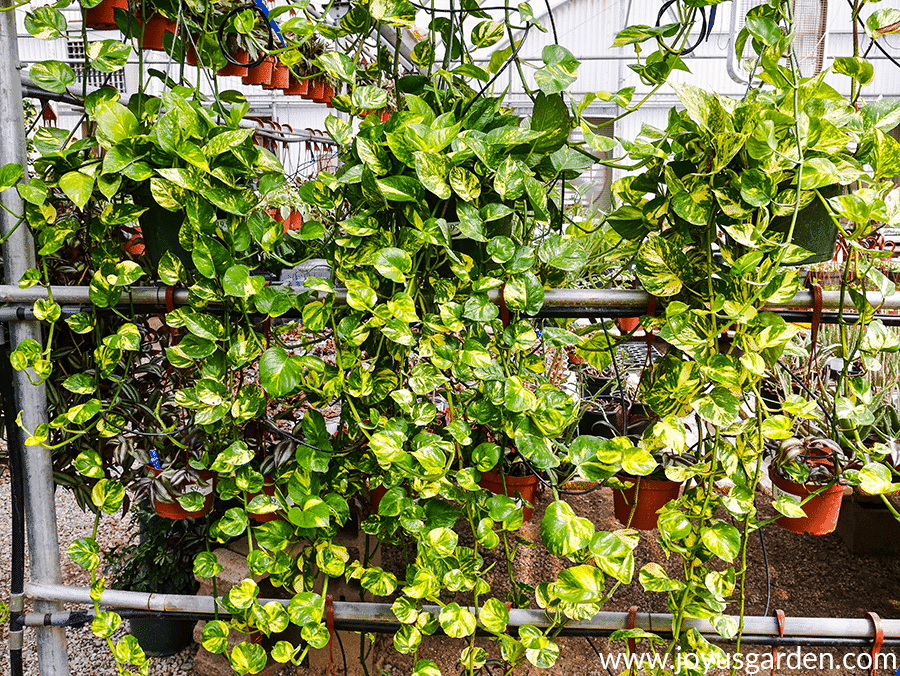
Golden Pothos hanging in the nursery with their renowned long trails.
Pothos aren’t fussy at all when it comes to the mix they’re planted in. I always use a good quality organic potting soil which is peat based, well nourished and drains well. Potting soil doesn’t actually contain soil. Garden soil is way too heavy for houseplants. Make sure whatever mix you buy says it’s formulated for houseplants somewhere on the bag.
Some Of Our General Houseplant Guides For Your Reference:
- Guide To Watering Indoor Plants
- Beginner’s Guide To Repotting Plants
- 3 Ways To Successfully Fertilize Indoor Plants
- How to Clean Houseplants
- Winter Houseplant Care Guide
- Plant Humidity: How I Increase Humidity For Houseplants
Best time for Pothos repotting:
Like all houseplants, spring & summer are the ideal times for Pothos repotting. If you live in a climate with temperate winters like me, early fall is fine. In a nutshell, you want to get it done at least 6 weeks before the colder weather sets in. Houseplants prefer not to be disturbed in the winter months & the roots settle in much better in the warmer months.
I repotted these 2 Pothos at the very end of March.

My 2 Pothos after being repotted. Time to go back in the house!
Soil mix for Pothos repotting:
Potting soil. I use Ocean Forest by Fox Farm. Here are the ingredients: Composted forest humus, sphagnum peat moss, Pacific Northwest sea-going fish emulsion, crab meal, shrimp meal, earthworm castings, sandy loam, perlite, bat guano, granite dust, Norwegian kelp, and oyster shell (for pH adjustment).
Charcoal. 1-3 handfuls depending on the pot size. Charcoal improves the drainage & absorbs impurities & odors.
Coco coir chips & fiber. 2-4 handfuls. This environmentally friendly alternative to peat moss is pH neutral, increases nutrient holding capacity & improves aeration. Pothos like to climb up trees in their native environments so I figure they’ll appreciate the chips & fiber.
Note: The charcoal, chips & compost are optional but I always have them on hand for my various & frequent potting projects. You can use all potting soil if you’d like. Another mix I’ve used for houseplants is 1/2 potting soil & 1/2 succulent & cactus mix.
I also mixed in a few handfuls of compost as I was planting as well as a 1/4″topping of worm compost. This is my favorite amendment, which I use sparingly because it’s rich. I’m currently using Worm Gold Plus. Here’s why I like it so much.
You can read how I feed my houseplants with worm compost & compost here: Compost for Houseplants.
Other Guides on Pothos Care
Pothos Care: the Easiest Trailing Houseplant
11 Reasons Why Pothos Is The Plant For You
Answering Your Questions About Pothos Care
Steps to Pothos repotting:
I’d suggest watching the video to get a better idea.
Water Pothos a few days before repotting. You don’t want your plant to be stressed during the process.
Put the plant on its side & gently press on the grow pot to loosen the root ball away.
Fill the grow pot with the amount of mix required to bring the top of the root ball even with or slightly below the top of the grow pot.
Place the Pothos in the pot & fill in around with mix. Top with worm compost & compost. (optional)
How often I repot my Pothos:
Pothos are moderate to fast growers. If you have it in low light, the growth rate will be slower. In their native environments they climb up trees & can reach 60′. That’s why they’re considered to be invasive, hard to get rid of & have earned another common name: Devil’s Ivy. Fortunately, we don’t have to worry about this in our homes!
I generally repot my Pothos every 2-3 years. As the trails grow longer, the roots grow more extensive. I could see the roots through the drain holes of the grow pots of my 2 but they weren’t popping out yet.
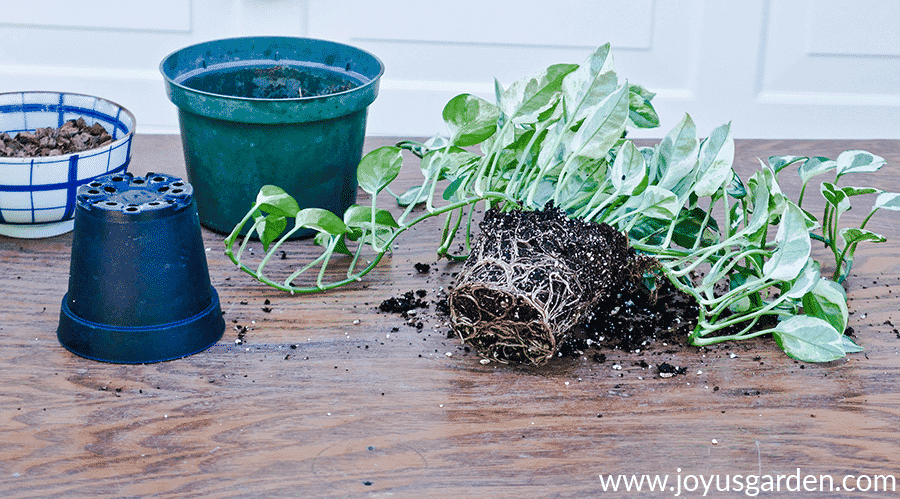
You can see the roots all bunched up at the bottom of the root ball. Pothos don’t mind being slightly root bound but they’ll be much happier with fresh new mix & a bigger pot.
Pot size you’ll need:
I usually go up a size – from 4″ to 6″ pot as an example. My Golden Pothos was in a 6″ grow pot & it went up to an 8″. The smaller N Joy was in a 4″ & I repotted it into a 6″ grow pot.
If your 6″ Pothos is large & extremely pot bound, then you can jump to a 10″ pot. Pot size doesn’t matter but I like to keep in in scale with the size of the plant.
Make sure the grow pot or decorative pot you’re planting your Pothos into has at least 1 drain hole. You want the excess water to readily drain out.
My trick for Pothos with long trails:
If your Pothos has numerous long trails they’ll get in the way of your repotting mission. My Golden Pothos has 7′ trails so I carefully put them in a large pillow case & loosely tied it towards the top. You’ll see me doing this towards the end of the video.
This way you can easily move the trails from side to side when you’re filling in the pot with mix. Untie the pillow case when you’re done & you shouldn’t have any broken leaves or stems. I use this method for working with hanging succulents which have leaves prone to falling off.
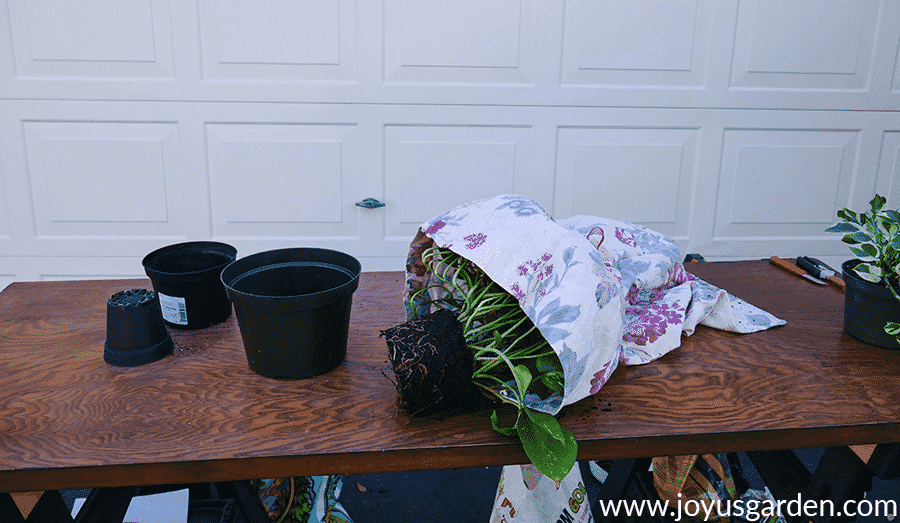
My Golden Pothos with its trails “contained” in a pillow case during the repotting process.
I watered both of these Pothos well right after being repotted. It took a few soakings to really get them well soaked because the mix ingredients were all dry.
Pothos are so to care for and tolerant of lower to medium light situations making them a “go to” houseplant. One of my friends has had a Pothos for over 20 years now – now that’s longevity! Propagation post coming soon.
Happy gardening,
Learn more about repotting houseplants:
Houseplant Repotting: Arrowhead Plant
What To Know About Planting Aloe Vera In Containers
Repotting Snake Plants: The Mix To Use & How To Do It
Transplanting My Dracaena Marginata With Its Cuttings
How to Plant & Water Succulents In Pots Without Drain Holes
Repotting Peperomia Plants (Plus The Proven Soil Mix To Use!)

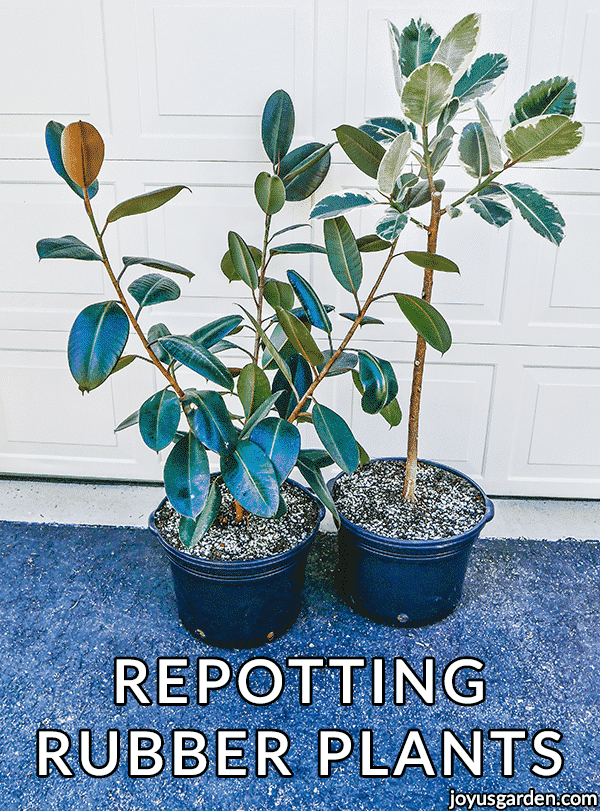
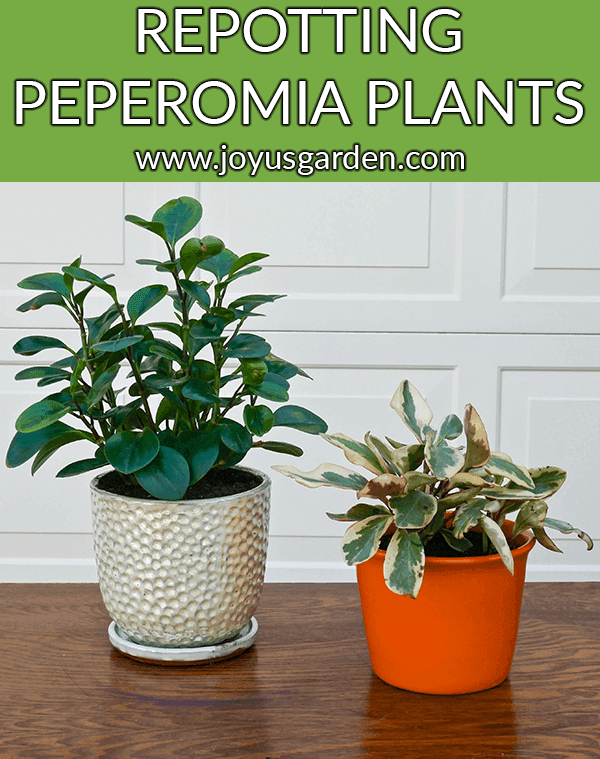
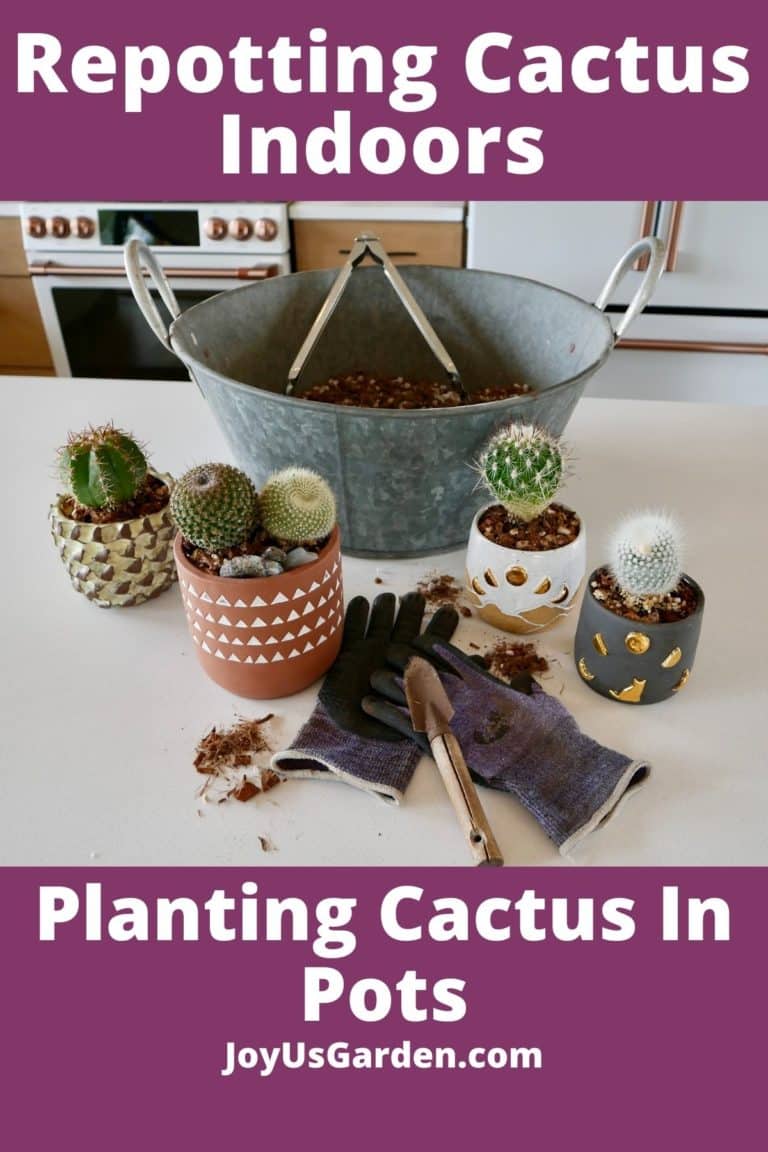
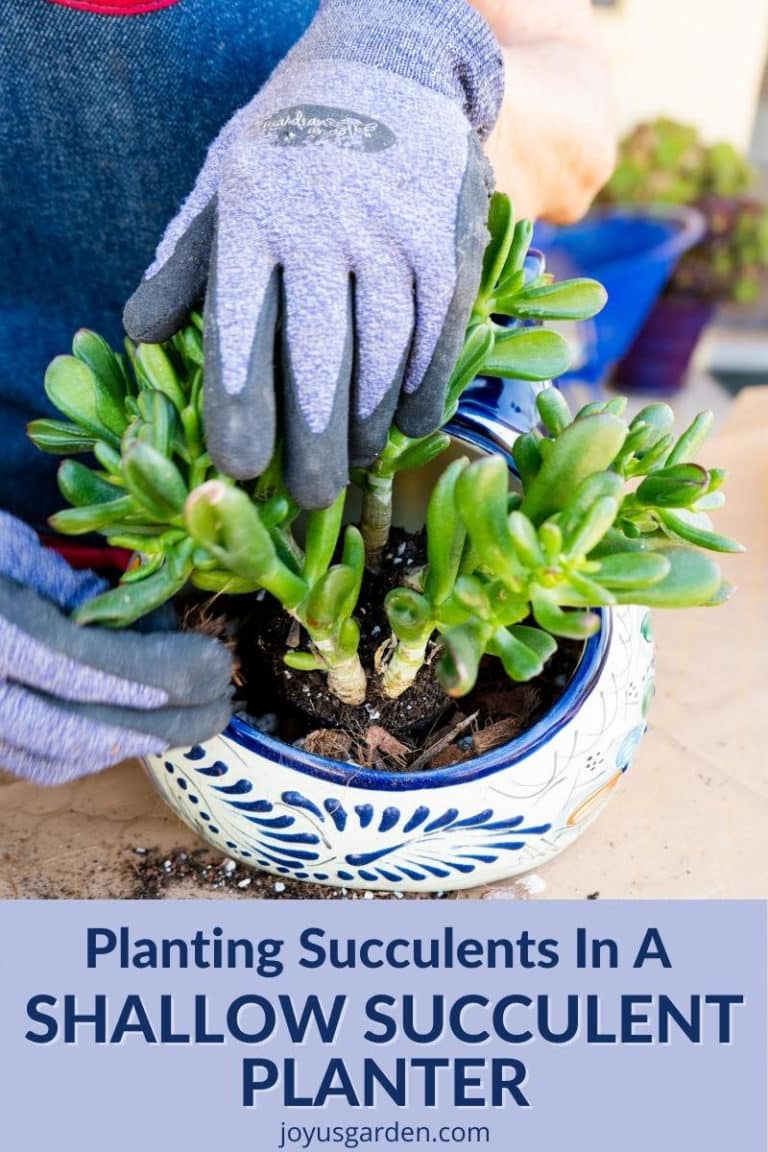

I repotted mine and it’s turning yellow. I had this plant for 2year it was from my dad funeral and the last thing I want it to do is die cause that’s all I have of him. Can you please help me
Hi Keshia – It’s hard to say. Pothos are tough & the most common cause of yellowing leaves is too much or too little water. Nell